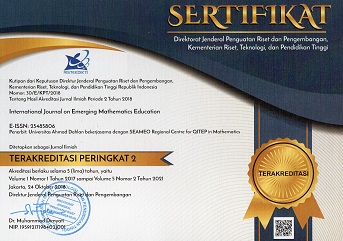Bar Model as Intervention in Solving Word Problem Involving Percentage
Abstract
Keywords
Full Text:
PDFReferences
Cole, B.L., & Weissenfluh, H.S. (1974). An analysis of teaching percentages. The Arithmetic Teacher, 21(3), 226- 228.
Curriculum Development Department. (2009). Mathematics Syllabus for Upper Primary Schools. Brunei: Curriculum Development Department (Ministry of Education).
Dole, S., Cooper, T., Baturo, A., & Conoplia, Z. (1997). Year 8, 9 and 10 students’ understanding and access of percent knowledge. In F. Biddulph & K. Carr (Eds.) People in mathematics education (Proceedings of the 20th Annual Conference of the Mathematics Education Research Group of Australasia). Rotorua, New Zealand: MERGA.
Garelick, B. (2006). Miracle math: a successful program from Singapore tests the limit of school reform in the suburbs. Education Next 4, 6(4), 40-45.
Han, S.H., Shahrill, M., Tan, A., Tengah, K.A., Jaidin, J.H. & Jawawi, R. (2016). Administering problem-based learning (PBL) approach in the teaching of college-level mathematics. Turkish Online Journal of Educational Technology, November Special Issue, 197-207.
Khalid, M., & Tengah, M.K.A. (2007). Communication in mathematics: the role of language and its consequences for English as second language students. Progress report, Collaborative Studies on Innovations for Teaching and Learning Mathematics in Different Cultures (II) Lesson Study focusing on Mathematical Communication. CRICED: University of Tsukuba.
Kho, T.H. (1987). Mathematical models for solving arithmetic problems. Proceedings of Fourth Southeast Asian Conference on Mathematical Education, 345-351, Singapore: Institute of Education.
Kho, T.H., Yeo, S.M., & Lim, J. (2009). The Singapore Model Method for Learning Mathematics. Singapore: EPB Pan Pacific.
Khoo, J.S., Shahrill, M., Yusof, N., Chua, G.L.L., & Roslan, R. (2016). Graphic Organizer in action: Solving secondary mathematics word problems. Journal on Mathematics Education, 7(2), 83-90.
Koay, P.L. (1998). The knowledge of percent of pre-service teachers. Mathematics Educator, 3(2), 54-69.
Larson, L.C. (1985). A discrete look at 1+2+ ... +n. The College Mathematics Journal, 16(5), 369-382.
Mahadi, N.A., Tengah K.A., & Prahmana R.C.I. (2018). The effect of using Bar Model to solve word problems on profit, loss and discount on students’ performance. Journal of Physics: Conference Series, 1097(1), 012103.
Ministry of Education. (2011). The National Education System for the 21st Century: SPN21 (revised). Brunei: Ministry of Education.
Ng, S.F., & Lee, K. (2009). The model method: Singapore children’s tool for representing and solving algebraic word problems. Journal for Research in Mathematics Education, 40(3), 282-313.
Ng, C.H.J., & Lim, K.H. (2001). A Handbook for Mathematics Teachers in Primary Schools of Singapore. Singapore: Federal Publications—Times Media Private Limited.
Pape, S.J. (2004). Middle school children’s problem-solving behavior: A cognitive analysis from a reading comprehension perspective. Journal for Research in Mathematics Education, 35(3), 187-219.
Parker, M., & Leinhardt, G. (1995). Percent: A privileged proportion. Review of Education Research, 65(4), 421-481.
Said, S.N. (2016). Supporting secondary mathematics students in solving word problems involving ratio through the Bar Model method. Thesis. Gadong: Universiti Brunei Darussalam.
Simpol, N.S.H., Shahrill, M., Li, H.C., & Prahmana, R.C.I. (2017). Implementing thinking aloud pair and Pólya problem solving strategies in fractions. Journal of Physics Conference Series, 943(1), 012013.
Smart, J.R. (1980). The teaching of percentage problems. School Science and Mathematics, 80(3), 187-192.
Soo, S.V., & Liu, Y.M. (2013). Mathematical Problem Solving – The Bar Model Method. Singapore: Scholastic Teaching Resources.
Sparrow, L., Kissane, B., & Hurst, C. (Eds.) (2010). Shaping the future of mathematics education. Proceedings of the 33rd annual conference of the Mathematics Education Research Group of Australasia. Fremantle: MERGA.
Tengah, K.A. (2011). Using simplified Sudoku to promote and improve pattern discovery skills among school children. Journal of Mathematics Education at Teacher College, 2(1), 53-62.
Ulat, T. (2006). Primary 5 pupils' performance on mathematical word problems using model-drawing/box-diagram strategy. Thesis. Gadong: Universiti Brunei Darussalam.
Veloo, P.K. (1996). Teaching children to draw diagrams in solving word problems: An exploratory study. Retrieved April 2, 2015 from http://www.merga.net.au/documents/RP_Veloo_1996.pdf
Veloo, P.K., & Wong, K.W. (1997). Multi-Modal Instruction. An Integrated Instructional Approach to Promote Conceptual Understanding in School Mathematics. Singapore: Educational Research Association.
Wong, C.M. (2018). Zollman’s four corners and a diamond graphic organizer as a solving strategy to improve performance in secondary mathematics word problems. Thesis. Gadong: Universiti Brunei Darussalam.
Xu, S. (2006). Study on mathematical word Problem Solving with Diagram-presentation among Primary School Students. Journal of Mathematics Education, 2, retrieved April 2, 2015 from http://en.cnki.com.cn/Article_en/CJFDTOTAL-SXYB200602017.htm
Yancey, A.V., Thompson, C.S., & and Yancey, J.S. (1989). Children must learn to draw diagrams. Arithmetic Teacher, 36(7), 15-19.
Yeap, B. H. (2014). Bar Modelling-A Problem-solving Tool. From Research to Practice: An Effective Singapore Math Strategy. Singapore: Marshall Cavendish Ed.
DOI: http://dx.doi.org/10.12928/ijeme.v3i1.11093
Refbacks
- There are currently no refbacks.
Copyright (c) 2019 Maimunah Abdul Gani, Khairul Amilin Tengah, Hardimah Said

This work is licensed under a Creative Commons Attribution 4.0 International License.
International Journal on Emerging Mathematics Education
Kampus 2 Universitas Ahmad Dahlan
Jalan Pramuka No. 42, Pandeyan, Umbulharjo, Yogyakarta - 55161
Telp. (0274) 563515, ext. 4902; Fax. (0274) 564604
Email: ijeme@uad.ac.id
p-ISSN: 2549-4996 | e-ISSN: 2548-5806
This work is licensed under a Creative Commons Attribution 4.0 International License

